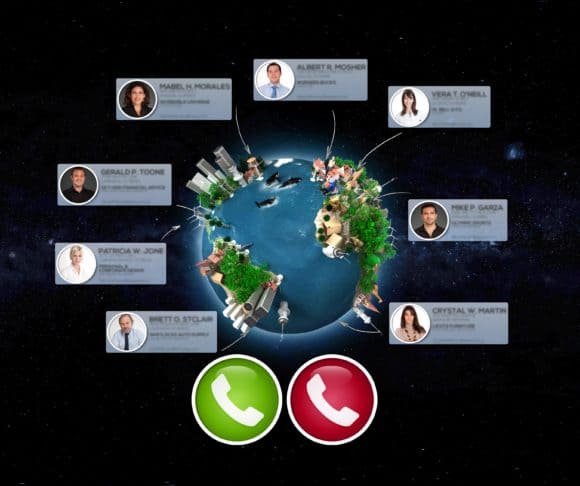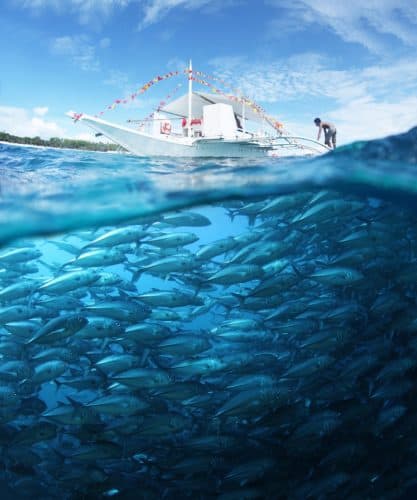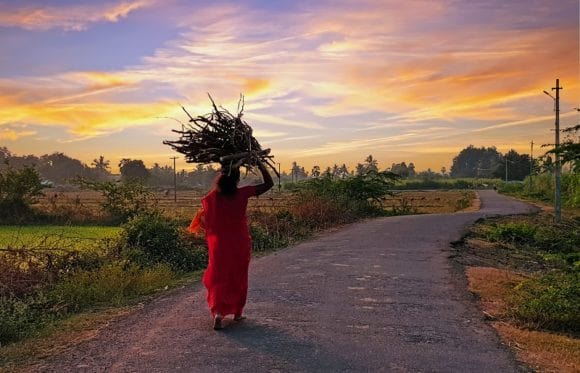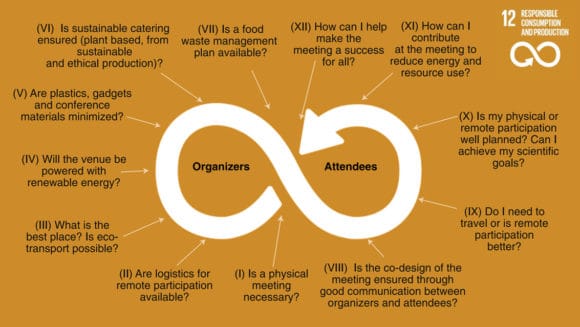May 14, 2020 | Alumni, Postdoc, Sustainable Development, Women in Science
By Raquel Guimaraes, postdoc in the IIASA World Population Program, and Debbora Leip, an alumnus of the IIASA Advanced Systems Analysis Program
IIASA researcher Raquel Guimaraes and former research assistant Debbora Leip encourage the support of the Cercedilla Manifesto, arguing that it is high time for the scientific community to take responsibility and set an example by making research meetings more sustainable.

© La Fabrika Pixel S.l. | Dreamstime.com
The research community widely agrees that strong action is needed to counteract the climate crisis that is currently taking place. Nevertheless, scientists regularly meet at conferences that are often far from sustainable. Problems range from participants flying to attend events, to unnecessary gadgets and gifts handed out at the meetings, and unsustainable catering at conference dinners. In light of the current public debate on environmental and social sustainability, we call on scientists to take a leading role in changing their work practices towards more sustainable habits, starting with research meetings.
In April 2020, Alberto Sanz-Cobena and several colleagues published an article titled Research meetings must be more sustainable in Nature Foods. They presented the Cercedilla Manifesto with 12 sustainability decisions as guidelines for organizers and attendees of research meetings (see Figure 1). The starting point of the manifesto is to question whether a physical meeting is indeed necessary. If organizers decide that it is, there is still the question of whether each single attendee really needs to physically join the conference. Often, remote participation can be equally efficient if a technical solution is provided by the organizers. Furthermore, if a decision to conduct a physical meeting is taken, organizers have to consider what food will be served.
The authors state that excessive amounts of food and food waste are very common at meetings, which makes a change of mindset towards better food management very important, not only for climate change, but for many other environmental threats. In our opinion, this point has so far been neglected in public debate.
Given the urgency for climate change action and the need for individuals to play an active role – with research scientists taking the lead – we assert that it is urgent to start changing our habits and setting an example regarding environmental and social sustainability in research meetings. Indeed, many of us take it for granted that to meet and discuss our work, we must travel. Most attendees do not even question that unnecessary gadgets and gifts are distributed or that opulent dinners are provided.
We hope that the Cercedilla Manifesto will raise awareness about the fact that good scientific output often does not require a physical meeting by providing a conceptual framework for change in this regard. If we support the manifesto, we stand a chance to lower the barrier to dare deviating from currently applied practices. The 12-sustainability decisions were designed by specialists to serve as a reference for anybody who wishes to organize/attend a sustainable meeting.
In the current situation brought about by the global COVID-19 crisis, almost everybody has experienced that remote conferences are not only possible, but also efficient – sometimes even more so than a physical meeting would have been. First, it saves time in terms of travel. Second, it may be more inclusive by allowing people to attend, who would not have had the opportunity to join otherwise, be it for financial, family, or other reasons. In addition, remote meetings provide additional features, like a chat function that could add another discussion layer.
Of course, remote meetings also have their limitations: informal in-person meetings during coffee breaks, for example, can enhance networking and free discussions, and sometimes contribute significantly to a meeting’s outcome. Virtual meetings also face several other challenges, such as participation by attendees from different time zones, or poor internet connections. These issues could however easily be addressed by spreading the meeting over more days, in such a way that the need for attendance outside of acceptable time slots is minimized, and by investing saved traveling costs into better equipment.
Let us learn from this experience and not go ‘back to normal’ after the COVID-19 crisis. We should take this as an opportunity to speed up change and tackle the other global crisis of climate change!
You can find the petition at openpetition.eu/!cercedillamanifesto. We encourage you to share and support this initiative.
References:
Sanz-Cobena A, Alessandrini R, Bodirsky BL, Springmann M, Aguilera E, Amon B, Bartolini F, Geupel M, et al. (2020). Research meetings must be more sustainable. Nature Food 1, 187–189. DOI: 10.1038/s43016-020-0065-2
Frisch B, & Greene C (2020). What it takes to run a great virtual meeting. Harvard Business Review. https://hbr.org/2020/03/what-it-takes-to-run-a-great-virtual-meeting?ab=hero-subleft-3
Note: This article gives the views of the author, and not the position of the Nexus blog, nor of the International Institute for Applied Systems Analysis.
Nov 21, 2019 | Air Pollution, Environment, Food & Water, Indonesia, Women in Science
By Adriana Gómez-Sanabria, researcher in the IIASA Air Quality and Greenhouse Gases Program
Adriana Gómez-Sanabria discusses the results of a new study that looked into the impacts of implementing various technologies to treat wastewater from the fish processing industry in Indonesia.

© Mikhail Dudarev | Dreamstime.com
To reduce water pollution and climate risks, the world needs to go beyond signing agreements and start acting. Translating agreements and policies into action is however always much more difficult than it might seem, because it requires all players involved to participate. A complete integration strategy across all sectors is needed. One of the advantages of integrating all sectors is that it would be possible to meet different objectives, for example, climate and water protection goals in this case, with the same strategy.
I was involved in a study that assessed the impacts of implementing various technologies to treat wastewater from the fish processing industry in Indonesia when involving different levels of governance. This study is part of the strategies that the government of Indonesia is evaluating to meet the greenhouse gas mitigation goals pledged in its Nationally Determined Contribution (NDC), as well as to reduce water pollution. Although Indonesia has severe national wastewater regulations, especially in the fish processing industry, these are not being strictly implemented due to lack of expertise, wastewater infrastructure, budgetary availability, and lack of stakeholder engagement. The objective of the study was to evaluate which technology would be the most appropriate and what levels of governance would need to be involved to simultaneously meet national climate and water quality targets in the country.
Seven different wastewater treatment technologies and governance levels were included in the analysis. The combinations included were: 1) Untreated/anaerobic lagoons – where untreated means wastewater is discharged without any treatment and anaerobic lagoons are ponds filled with wastewater that undergo anaerobic processes – combined with the current level of governance. 2) Aeration lagoons – which are wastewater treatment systems consisting of a pond with artificial aeration to promote the oxidation of wastewaters, plus activated sludge focused solely on water quality targets with no coordination between water and climate institutions. 3) Swimbed, which is an aerobic aeration tank focusing mainly on climate targets assuming no coordination between institutions. 4) Upflow anaerobic sludge blanket (UASB) technology, which is an anaerobic reactor with gas recovery and use followed by Swimbed, and 5) UASB with gas recovery and use followed by activated sludge, which is an aerobic treatment that uses microorganisms forming particles that clump together. Both, 4 and 5 assume vertical and horizontal coordination between water and climate institutions at national, regional, and local level. It is important to notice that the main difference between 4 and 5 is the technology used in the second step. Two additional combinations, 6 and 7, are also proposed including the same technological combinations of 4 and 5, but these include increasing the level of governance to a multi-actor coordination level. The multi-actor level includes coordination at all institutional levels but also involves academia, research institutes, international support, and other stakeholders.
Our results indicate that if the current situation continues, there would be an increase of greenhouse gases and water pollution between 2015 and 2030, driven by the growth in fish industry production volumes. Interestingly, the study also shows that focusing only on strengthening capacities to enforce national water policies would result in greenhouse gas emissions five times higher in 2030 than if the current situation continues, due to the increased electricity consumption and sludge production from the wastewater treatment process. The benefit of this strategy would be positive for the reduction of water pollution, but negative for climate change mitigation. From our analyses of combinations 2 and 3 we learned that technology can be very efficient for one purpose but detrimental for others. If different institutions are, for example, responsible for water quality and climate change mitigation, communication between the institutions is crucial to avoid trade-offs between environmental objectives.
Furthermore, when analyzing different cooperation strategies together with a combination of diverse sets of technologies, we found that not all combinations work appropriately. For instance, improving interaction just within and between institutions does not guarantee proper selection and application of technologies. In this case, the adoption of the technology is not fast enough to meet the targets proposed in 2030, thus resulting in policy implementation failures. Our analyses of combinations 4 and 5 showed that interaction within and between national, regional, and local institutions alone is not enough to prevent policy failure.
Finally, a multi-actor cooperation strategy that includes cooperation across sectors, administrative levels, international support, and stakeholders, seems to be the right approach to ensure selection of the most appropriate technologies and achieve policy success. We identified that with this approach, it would be possible to reduce water pollution and simultaneously decrease greenhouse gas emissions from the electricity required for wastewater treatment. Analyzing combinations 6 and 7 revealed that multi-actor governance allows to simultaneously meet climate and water objectives and a high chance to prevent policy failure.
In the end, analyses such as the one shown here, highlight the importance of integrating and creating synergies across sectors, administrative levels, stakeholders, and international institutions to ensure an effective implementation of policies that provide incentives to make careful choices regarding multi-objective treatment technologies.
Reference:
Gómez-Sanabria A, Zusman E, Höglund-Isaksson L, Klimont Z, Lee S-Y, Akahoshi K, Farzaneh H, & Chairunnisa (2019). Sustainable wastewater management in Indonesia’s fish processing industry: bringing governance into scenario analysis. Journal of Environmental Management (Submitted).
Note: This article gives the views of the author, and not the position of the Nexus blog, nor of the International Institute for Applied Systems Analysis.
Oct 15, 2019 | IIASA Network, Science and Policy, South Africa
Bettina Greenwell, communications officer at IIASA, talks to Dorsamy (Gansen) Pillay, Deputy CEO: Research and Innovation Support and Advancement (RISA), National Research Foundation (NRF), and IIASA council member for South Africa, about the NRF’s statement on ethical research and scholarly publishing practices. The statement was jointly issued in August 2019 with South African partners within the National System of Innovation (NSI) in South Africa.

Dorsamy (Gansen) Pillay, Deputy CEO: Research and Innovation Support and Advancement (RISA), National Research Foundation (NRF), and IIASA council member for South Africa
What is ethics in research and why is it so important?
Research is a quest for truth. The research must be well conceptualized with a clear research question(s) which can lead to new knowledge. Good ethics and integrity dictate that the truth must be presented in its absolute form, and the findings need to be appropriately interpreted and should be reproducible.
South Africa was awarded the right to host the 7th World Conference on Research Integrity (WCRI) in 2021 in Cape Town – the first time it will be hosted on an African continent. Why is this statement important for the science community in South Africa?
Firstly, it is a privilege to host this conference and South Africa feels very honored. The statement on ethical research and scholarly publishing practices is an important contribution to this conference. We have noticed that South African academics and researchers, especially new and emerging researchers, are under a lot of pressure to publish their work for a variety of reasons. In some instances, ethical principles have been violated. This included the dissemination of research through predatory journals. However, this was not unique to South Africa only as other countries also faced similar challenges. The NRF as a science granting foundation felt compelled to respond to this challenge. The NRF sees itself as a custodian and guardian of research ethics and integrity. Through our peer-review processes, we ensure that research proposals for funding have been robustly interrogated, and the highest ethical principles upheld. As a consequence the NRF developed and issued a joint statement on ethical research and scholarly publications in collaboration with the Department of Science and Innovation (DSI), the Department of Higher Education and Training (DHET), the Council on Higher Education (CHE), the Academy of science of South Africa (ASSAf), Universities South African (USAf) and the NRF. In addition, the NRF has previously issued a statement on predatory publishing.
What do you think will be the key scientific challenges to face South Africa in the next few years? And how do you envision IIASA helping South Africa to tackle these?
There are several challenges, and some of the most pressing ones are poverty and inequality, population migration and unemployment. Given the systems analysis approach, we feel we can draw on IIASA’s expertise to address these challenges. IIASA has used South Africa as a laboratory for its population studies research over several years. It is now time to ensure that this research is translated into policies so that it may impact positively on society.
Housing is also a problem in South Africa. There is a lack of decent, affordable housing for people. The new IIASA strategic plan focuses on smart cities – this could play a role in addressing these housing challenges.
IIASA’s expertise is a systems analysis approach which can be applied to complex issues. The important part of the work is when scientific results are turned into policy – that’s when there is an actual, tangible societal benefit.
South Africa has been an IIASA member since 2007. What have been the highlights of the South Africa-IIASA membership until now?
We see the South Africa IIASA membership as a partnership, and many benefits have accrued through this partnership over the past decade. An example is the Southern African Young Scientists Summer Program (SA-YSSP), which was inspired by the success of the IIASA YSSP. This program ran from 2012 to 2015, and trained the next generation of young scientists.
Another example is the Southern African Systems Analysis Centre (SASAC) initiative, which focused on expanding systems analysis expertise in Southern Africa. Both initiatives were endorsed by the South African Department of Science and Innovation.
About NRF and Dorsamy (Gansen) Pillay
As an entity of the Department of Science and Technology (DST), the NRF promotes and supports research through funding, human resource development and the provision of National Research Facilities in all fields of natural and social sciences, humanities and technology. Dr Dorsamy (Gansen) Pillay is currently the Deputy Chief Executive Officer (DCEO): Research and Innovation Support and Advancement (RISA) of the National Research Foundation (NRF) of South Africa. His thirty-year career in research, teaching, management and leadership includes academic, management and leadership positions at the former University of Durban-Westville and at the Durban University of Technology. His research has focused on both prokaryotic and eukaryotic microorganisms, from human diseases to bacterial plant diseases with particular emphasis on elucidating the molecular architecture of the causal microorganisms with a view to understanding genetic diversity, extra-chromosomal elements and developing rapid disease diagnoses. He is currently Vice Chair of the IIASA Council.
Notes:
Please click on the link to read the statement on ethical research and scholarly publishing.
More information on IIASA and South Africa.
This article gives the views of the authors, and not the position of the Nexus blog, nor of the International Institute for Applied Systems Analysis.
Sep 23, 2019 | Ecosystems, Environment, Sustainable Development
By Frank Sperling, Senior Project Manager (FABLE) in the IIASA Ecosystems Services and Management Program
Food and land use systems play a critical role in managing climate risks and bringing the world onto a sustainable development trajectory.
The UN Secretary General’s Climate Action Summit in New York on 23 September seeks to catalyze further momentum for climate change mitigation and adaptation. The transformation of the food and land use system will play a critical role in managing climate risks and bringing the world onto a sustainable development trajectory.
Today’s food and land use systems are confronted with a great variety of challenges. This includes delivering on universal food security and better diets by 2030. Over the last decades, great strides have been made towards achieving universal food security, but this progress recently grinded to a halt. The number of people suffering from chronic hunger has been rising again from below 800 million in 2015 to over 820 million people today [1]. Food security is however not only about a sufficient supply of calories per person. It is also about improving diets, addressing the worldwide increase in the prevalence of obesity, and how we use and value environmental goods and services.

© Paulus Rusyanto | Dreamstime.com
Agriculture, forestry and other land use currently account for around 24% of greenhouse gas emissions caused by human activities [2]. Land use changes are also a major driver behind the worldwide loss of biodiversity [3]. Clearly, in light of population growth and the increasingly visible fingerprints of a human-induced global climate crisis and other environmental changes, business as usual is not an option.
Systems thinking is key in shifting towards more sustainable practices. A new report released by the Food and Land-Use System (FOLU) Coalition showcases that there is much to be gained. There are massive hidden costs in our current food and land use systems. The report outlines ten critical transitions, which can substantially reduce these hidden costs, thereby generating an economic prize, while improving human and planetary health.
The International Institute for Applied Systems Analysis (IIASA) contributed to the analytics underpinning the report [4], applying the Global Biosphere Management Model (GLOBIOM) [5]. A “better futures” scenario, which seeks to collectively address development and environmental objectives, was compared to a “current trends” scenario, which is basically a continuation of a business-as-usual scenario. The assessment illustrates that an integrated approach that acknowledges the interactions in the food and land use space, can help identify synergies and manage trade-offs across sectors. For example, shifting towards healthy diets not only improves human health, but also reduces pressure on land, thereby helping to improve the solution space for addressing climate change and halting biodiversity loss.
While understanding that the global picture is important, practical solutions require engagement with national and subnational governments. The challenge is to identify development pathways that address the development needs and aspirations of countries within global sustainability contexts. As part of FOLU, the Food, Agriculture, Biodiversity, Land and Energy (FABLE) Consortium was initiated to do exactly this. The FABLE Secretariat, jointly hosted by the Sustainable Development Solutions Network (SDSN) and IIASA, is working with knowledge institutions from developed and developing countries, to explore the interactions between national and global level objectives and their implications for pathways towards sustainable food and land use systems. Preliminary results from inter-active scenario and development planning exercises, so-called Scenathons, were recently presented in the FABLE 2019 report.
These initiatives highlight that acknowledging and embracing complexity can help reconcile development and environmental interests. This also entails rethinking how we relate to and manage nature’s services and their role in providing the foundation for the welfare of current and future generations. This is underscored by the prominent role nature-based solutions are given at the UN Secretary General’s Climate Action Summit. We need to move from silo-based, sector specific, single objective approaches to a focus on multiple objective solutions. In the land use space, this means embedding agriculture in the broader land use context, which accounts for and values environmental services, and linking to the food system where dietary choices shape human health and the demand for land.
Doing so will help bridge the international policy objectives of the UN Framework Convention on Climate Change (UNFCCC), the UN Convention on Combating Desertification (UNCCD), the Convention on Biological Diversity (CBD), and the Sustainable Development Goals (SDGs) enshrined in ‘The 2030 Agenda for Sustainable Development’. This represents an opportunity to create a new value proposition for agriculture and other land use activities where environmental stewardship is rewarded.
References
[1] Food and Agriculture Organization (FAO) et al. (2019). The State of Food Security and Nutrition in the World 2019. Safeguarding against economic slowdowns and downturns. Rome, FAO.
[2] Intergovernmental Panel on Climate Change (IPCC) (2019). Climate Change and Land. IPCC Special Report on climate change, desertification, land degradation, sustainable land management, food security, and greenhouse gas fluxes in terrestrial ecosystems. Intergovernmental Panel on Climate Change (IPCC).
[3] Intergovernmental Science-Policy Platform on Biodiversity and Ecosystem Services (IPBES) (2018). The IPBES assessment report on land degradation and restoration. Montanarella, L., Scholes, R., and Brainich, A. (eds.). Secretariat of the Intergovernmental Science-Policy Platform on Biodiversity and Ecosystem Services, Bonn, Germany. 744 pages.
[4] Deppermann, A. et al. 2019. Towards sustainable food and land-use systems: Insights from integrated scenarios of the Global Biosphere Management Model (GLOBIOM). Supplemental Paper to The 2019 Global Consultation Report of the Food and Land Use Coalition Growing Better: Ten Critical Transitions to Transform Food and Land Use. Laxenburg, IIASA.
[5] Havlik P, Valin H, Herrero M, Obersteiner M, Schmid E, Rufino MC, Mosnier A, Thornton PK, et al. (2014). Climate change mitigation through livestock system transitions. Proceedings of the National Academy of Sciences 111 (10): 3709-3714. DOI: 1073/pnas.1308044111 [pure.iiasa.ac.at/10970].
Note: This article gives the views of the author, and not the position of the Nexus blog, nor of the International Institute for Applied Systems Analysis.
Jul 22, 2019 | Air Pollution, China, India, Women in Science
By Shonali Pachauri, Senior Researcher in the IIASA Energy Program
Shonali Pachauri explains why data, indicators, and monitoring at finer scales are important to ensure that everyone benefits from policies and efforts aimed at achieving national and global development goals.
A world where no one is left behind by 2030, is the promise nations have made by adopting the United Nations’ Agenda for Sustainable Development. But how does one ensure that no one is left behind? It requires designing inclusive policies and programs that target the most vulnerable and marginalized regions and populations. Sound data and indicators underpin our current understanding of the status of development and are an important part of periodic reviews to determine the direction and pace of progress towards achieving agreed goals. These form the basis of informed decisions and evidence-based policymaking. While an exhaustive list of indicators has been prescribed to monitor progress towards the globally agreed goals, these have been largely defined at a national scale. These goals rely overwhelmingly on simple averages and aggregates that mask underlying variations and distributions.

Indian woman walking home with fire wood © Devy | Dreamstime.com
Recent work I’ve been involved in makes the pitfalls of working with averages and aggregates alone abundantly clear. They can obscure uneven patterns of changes and impacts across regions and groups within the same nation. The overall conclusion of this work is that, even if the globally agreed goals are met by 2030, this is no guarantee that everyone will benefit from their achievement.
A recent Nature Energy – News & Views piece I was invited to write reports on a study that assessed the impacts of China’s recent coal to electricity program across villages in the Beijing municipal region. The program subsidizes electricity and electric heat pumps and has been rolling out a ban on coal use for household heating. The study found that the benefits of the program to home comfort, air quality, and wellbeing varied significantly across rich and poor districts. In poor districts, the study found that the ban was not effective as poor households were still unable to afford the more expensive electric heating and were continuing to rely on coal. Studies such as this one that help us understand how and why benefits of a program may vary across regions or population groups can aid policy- and decision makers in formulating more fair and inclusive policies.
In other recent research carried out with colleagues in the IIASA Energy Program, the Future Energy Program at the Fondazione Eni Enrico Mattei (FEEM) in Italy, and the Institute for Integrated Energy Systems at the University of Victoria, Canada, we developed a detailed satellite nightlights derived dataset to track progress with providing electricity access at a sub-national level in Africa. We found that while progress with electrification between 2014 and 2018 varied across nations, at a sub-national provincial level, disparities were even more pronounced. Even more surprising, while electricity access is generally higher and easier to extend in urban areas, we found urban pockets where access has stagnated or even worsened. This correlated with areas where in-migration of populations had been high. These areas likely include urban slums or peri-urban regions where expanding electricity access continues to be challenging. Furthermore, our analysis shows that even where access has been extended, there are regions where electricity use remains extremely low, which means that people are not really benefitting from the services electricity can provide.
In a final example, of research carried out with collaborators from the University of British Columbia and the Stockholm Environment Institute, we evaluated a large nationwide program to promote cooking with liquefied petroleum gas (LPG) in Indian households to induce a shift away from the use of polluting solid fuels. While this program specifically targets poor and deprived, largely rural households, our assessment found that although there has been an unprecedented increase in enrollments of new LPG customers under the program, this has not been matched by an equal increase in LPG sales. In fact, we found consumption of LPG by program beneficiaries was about half that of the average rural consumer. Moreover, when we examined how purchases were distributed across all new consumers, we found that about 35% of program beneficiaries purchased no refills during the first year and only 7% bought enough to substitute half or more of their total cooking energy needs with LPG. Clearly, the health and welfare benefits of a transition to cleaner cooking are still to be realized for most people covered by this program.
Analyses, such as the examples I’ve discussed here, clearly highlight that we need data, indicators, and monitoring at much finer scales to really assess if all regions and populations are benefitting from policies and efforts to achieve national and globally agreed development goals. Relying on aggregates and averages alone may paint a picture that hides more than it reveals. Thus, without such finer-scale analysis and an understanding of the distributional impacts of policies and programs, we may end up worsening inequalities and leaving many behind.
References:
[1] Pachauri S (2019). Varying impacts of China’s coal ban. Nature Energy 4: 356-357. [pure.iiasa.ac.at/15905]
[2] Falchetta G, Pachauri S, Parkinson S, & Byers E (2019). A high-resolution gridded dataset to assess electrification in sub-Saharan Africa. Scientific Data 6 (1): art. 110. [pure.iiasa.ac.at/15982]
[3] Kar A, Pachauri S, Bailis R, & Zerriffi H (2019). Using sales data to assess cooking gas adoption and the impact of India’s Ujjwala program in rural Karnataka. Nature Energy [pure.iiasa.ac.at/15994]
Note: This article gives the views of the author, and not the position of the Nexus blog, nor of the International Institute for Applied Systems Analysis.







You must be logged in to post a comment.